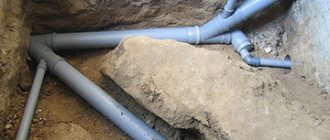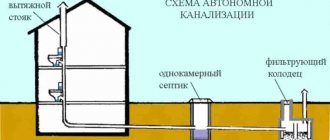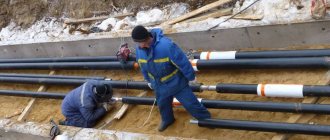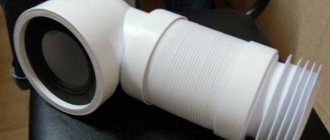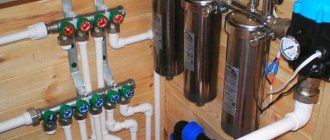A fecal pump is a device with increased capacity designed for pumping viscous liquids with suspended large particles. Used for cleaning cesspools and septic tanks, and for pumping out individual sewage systems. The sewage pump pumps viscous media that may contain solid particles no larger than 50 mm in size.
The system for removing wastewater generated during life processes can have various designs, including those with forced pumping of the contents.
At the same time, in a private house, fecal pumps are often used for sewage, especially if the sources of feces are located in the basement or basement floors.
In this article we will analyze in detail the principle of operation, technical characteristics, device, where sewage pumps are used, where they are installed (behind the toilet, bathtub or sink, etc.).
Using fecal pumps in a private home
Owners of private country houses, one way or another, have to clean the sewer system on the site. This can be done by calling a special service with a sewage disposal machine, but such an operation is very expensive, so many people prefer to solve the pumping problem themselves.
Pumping out contaminated water can be done using two types of units - drainage or fecal.
The difference between them, at first glance, seems insignificant, but it is fundamentally important. The first of them are designed for pumping heavily contaminated media, including various solid objects up to 5 centimeters in size. To prevent them from getting inside the device, a metal mesh is installed at the pump inlet.
Fecal water has a slightly different consistency. They are a thick liquid, often including fibrous contaminants in the form of clumps of rags, hair, animal fur and other similar substances. The mesh of the drainage unit becomes clogged with them very quickly, and it stops working.
To eliminate this problem, a grinder is installed on fecal models of sewage pumps in private homes.
Thus, drainage pumps for sewage systems are practically not used in private homes.
Installing the device at home for a cesspool
Installation of semi-submersible
A special platform is made on the wall of the tank. The electric pump will be securely fixed on it.
Considering that its body is not airtight, a float mechanism and a water level sensor are installed. A pipe for pumping wastewater is immersed into the source. At the same time, the electric pump itself is protected from possible moisture from entering from above.
Installation of submersible
There are several ways to install a self-priming unit for a private home.
Method No. 1
- A platform is made at the bottom of the septic tank.
- A sewage pump is attached to the site using anchors.
- A pipe for pumping out liquid is brought to the surface.
Method No. 2
- A chain or steel cable is attached to the device.
- At the same time, the electrical cable and pumping pipe are connected.
- To pump liquid, the pump is carefully lowered along a cable and immersed in the source.
- After pumping the sewer, the pump rises.
Surface mounting
The principle of operation of a surface fecal pump requires installation of the motor on the surface. At the same time, it is mounted on a flat and durable surface. The unit has two pipes: through one the liquid is sucked in, and through the other it is pumped out.
The secured hose or pipe is immersed into the source. If it is impossible to install the unit permanently, after completion of the work everything is disassembled and removed. If it is possible to protect the motor from rain and other atmospheric phenomena, then the system operates in stationary mode.
Sewage pump - principle of operation, design and technical characteristics
This is a small device that allows you to accumulate, grind and move contaminated masses of high viscosity.
Wilo fecal pumps: design and operating principles
The main advantage of fecal units for a private home is their ability to pump thick masses of sewage over a distance of up to 100 meters and to a height of up to 7 meters.
How equipment for pumping feces works
Such units have a rather complex design, consisting of the following elements:
- Frame. It can be made of durable plastic, cast iron or stainless steel. Considering the conditions of use in an aggressive environment, the last option is the best. The increased strength housing is used on submersible pumps for pumping.
- Stator and rotor - the parts that form the propulsion system - are placed coaxially.
- The shaft connected to the rotor transmits rotation from the electric motor to the working part of the device.
- A sealing system that isolates the insides of the mechanism from an aggressive environment.
- An impeller that directly acts on the pumped substance and sets it in motion from the suction pipe to the outlet pipe.
- A cover covering the internal structure of the device.
- Oil chamber protects the mechanism from overheating during operation.
In addition, the device is equipped with brackets for attaching cables and hoses.
Operating principle of the unit
Despite the apparent complexity of the design, the operation of the device is quite simple. When rotating, the impeller carries fecal waste towards the inlet pipe, simultaneously crushing its solid fractions.
Under pressure, the mass is supplied towards the outlet pipe on which the hose is installed.
Technical characteristics of a device for forced sewerage in a private house
In itself, forced sewerage in a private house is needed only in special cases when it is impossible to arrange a gravity drainage system.
This, as a rule, is determined by the design features of the building itself, if the forming plumbing fixtures are located in basements or basements.
Sewage pump for home sewage. Sewage pumping station.
In this case, wastewater is forcibly pumped from the collector into the septic tank, and if there is a connection to a centralized sewerage system, then directly there.
The following technical characteristics are relevant here:
- Pump performance - how much waste can be pumped out per hour of operation (for example, 150-400 liters).
- Power consumption – for a private home, the use of low power units is sufficient – up to 400 W/hour.
- Depth of immersion or height of lifting of the column - for fecal pumps, a value of 15 meters is sufficient for this indicator.
- Power supply – in sewer stations for a private home, equipment with an operating voltage of 220 Volts is used.
These are the main characteristics for a home sewage station. Equipment parameters are very diverse, but there is always an optimal combination for a particular case.
Which is better - submersible or surface?
With the same output pressure, a submersible sewage pump consumes less power than its external self-priming counterpart. The former simply does not have to waste energy on sucking wastewater through the outlet from the bottom of the container to the working chamber. All the power of the electric motor is spent on creating pressure in the pressure line.
A pump completely immersed in wastewater produces an order of magnitude less noise than one installed on the surface. Water absorbs most of the sounds produced by the electric motor and the rotating working elements of the pump.
Surface equipment is noisier than equipment immersed in a sewer tank, which is cooled by the liquid around it
In terms of ease of use, the palm can be given to the surface model, but only if it is compact and portable. Plus, the correctness of its operation can be monitored simply by the noise it makes. If the electric motor does not operate correctly, extraneous sounds appear, immediately indicating problems.
With all other parameters and additional equipment being equal, a surface pumping station will almost always cost less than a submersible sewage pump. Of course, a lot depends on the manufacturer and competition in a particular region.
However, equipment immersed in sewage is, by definition, more technologically advanced and more complex, which determines its higher price.
Main varieties
With all the variety of models of such equipment, they are divided into several categories:
Submersible units are made from high-strength materials and are equipped with a float on/off device. The housing is sealed and equipped with durable gaskets, reliably protecting the internal structure from the penetration of aggressive liquids. The main area of application of submersible devices is for pumping out the contents of cesspools, but they can be just as successfully used for pumping out storm sewer collector wells. And absolutely nothing prevents them from being used for watering vegetable gardens. Thus, by purchasing a submersible unit, you can solve many problems.
Installation of such a pump is carried out by attaching a suction pipe to the bottom of the tank, to which the unit itself is attached. The float switch ensures timely shutdown of the unit, preventing it from operating outdoors. The pumped substance plays the role of a cooling agent. A submersible sewer pump in a private home is one of the most reliable units in its class.
Semi-submersible fecal models are characterized by a reduced size of the outlet pipe. The maximum particle size is 15 millimeters. But such devices are equipped with a solid inclusion destroyer, so they are successfully used for pumping sewage waste in a private home. Semi-submersible units are most often installed on a floating platform, and their position always corresponds to the level of the pumped liquid.
When installing such a unit, the lower part is located in the liquid, the upper part is above its level.
Surface pumps are usually installed outside the tank and therefore require the use of a protective casing. Such units are not characterized by high productivity, and the maximum permissible size of solid inclusions is no more than 5 millimeters. However, the long service life and very affordable price of such a unit make it very popular among residents of country houses.- Domestic sewage pumping stations are designed to solve a number of specific problems related to the organization of wastewater disposal. In this case, the following points are resolved:
- the possibility of including plumbing equipment located below the level of the main sewer line into the general drainage system. The equipment allows you to lift liquid to a height of 5 to 15 meters, which allows you to place household plumbing in the basement and basement floors;
With the use of such equipment, it becomes possible to transport wastewater over a distance of up to 100 meters, without worrying about compliance with slope rules for gravity systems. The problem of possible seasonal soil movements that deform an extended pipeline is also being solved.- The use of a grinder in a sewerage pumping station makes it possible to obtain a pumped-out substance of a homogeneous mass, which makes it possible to use pipes with a diameter of 40-50 millimeters.
- Such installations make it possible to introduce a carbon filter into the design, which eliminates the smell of sewage from the room.
The criteria for choosing a station installation are the following circumstances:
- The depth of the location of the main sewer system and the presence of a height difference between them and the connected plumbing equipment.
- Type of wastewater - temperature and characteristics of contaminants.
- The estimated volume of sewage waste expected to be pumped by the pumping station when used in normal mode.
- The need for a device to operate in automatic mode and the choice of method for controlling the installation.
Pumping units for domestic use are available in compact designs and can be installed directly under the sink, bathtub or behind the toilet without taking up much space.
Advantages and disadvantages
The main advantage of the compact device is the possibility of arranging sewerage as part of repairs after construction and installation with a low location of plumbing equipment (below the drain hole). When installing powerful pumps, the pipe diameter is 50 mm. Such a plumbing network can be easily disguised. If you cannot hide it, then it does not stand out as much as an installation made from a pipeline with a diameter of 100 mm.
A sanitary pumping station can be installed both in the kitchen and in the bathroom.
The pumps have the following disadvantages:
- Device noise. Some companies are improving their models, but the noise does not go away.
- Burnout of devices. The device can work for several years if it was chosen correctly and large objects do not fall into the sewer. If the choice of model was incorrect and the device works at its maximum, then it breaks down. The toilet pump must have high power.
- Electricity requirement. When there is no power, the drain does not function. To ensure uninterrupted operation, a backup source is required.
- Correct operation. Fibrous materials and hair should not get into the cutting element, which wrap around the screw and reduce the quality of grinding. After some time, the screw will stop working normally. The equipment will not burn out, since the overheating sensor will work, but the installation will need to be disassembled and cleaned.
Sewage grinders
In the case of processing household wastewater, you first need to figure out what materials need to be crushed:
- In addition to grease, kitchen sinks can also release food debris into the drain and cause a clog unless it is mixed with other fibrous materials from other sources.
- The most annoying items in sinks and washing machine drains are fibrous materials, hair, and animal dander. Combining with fats from the kitchen sink, they can create dense clogs.
- The toilet sewer pump removes the most significant clogging items, such as paper, various napkins and tampons.
The shredder has to deal with all these waste-contaminating materials.
Essentially, this design element works like an ordinary meat grinder. In this case, the role of the auger for moving the crushed mass is performed by the device itself, creating a retracting force.
Taking into account the characteristics of the processed material, high-strength materials made of alloyed stainless steel are used for the manufacture of knives and grilles.
Knives of the following shapes are practiced for installation:
- in the form of impellers with knives - blades;
- cutter based on the principle of a meat grinder;
- cylindrical scissors-knives;
- cross secateurs;
- lamellar cutters.
Automatic operation
Operating pumping equipment manually is quite inconvenient, since it will need to be constantly turned on and off, which means you need to be near the unit.
It is much better when the pump comes with:
- A float
is an element that determines the level of waste in the storage tank and the need to turn the device on or off. - Thermal relay
is a part that is activated when the temperature of the electric motor rises to a critical level and prevents it from overheating by turning it off.
Some manufacturers of sewage pumps with a built-in grinder include the ability to self-clean its cutting mechanism, which increases the life of the unit without stopping for maintenance and reduces the likelihood that the electric motor will overheat.
Choosing a pump for a private home
When choosing such an installation for the sewage system of a private house, you should take into account the parameters of the system itself, namely:
- Supply voltage, and, consequently, energy consumption for pumping fecal waste. For a private home, a voltage of 220 volts is usually sufficient, but units designed for 380 are also available for sale.
- The power consumption parameter is important. Taking into account real loads, equipment less than 400 watts for fecal pumps is practically not produced. However, if we are talking about the sewage system of a private house, this power is quite enough.
- Such a parameter as the pressure it creates directly depends on the power of the pump. This characteristic is expressed in meters of water column, but it does not show the lifting height itself, but also the force required to overcome the resistance of a horizontal pipeline. The pressure when pumping thick fecal wastewater has a slightly different meaning, so manufacturers of fecal pumps provide real indicators in the form of a table in the accompanying technical documentation.
- For submersible pumps, the parameter of the permissible depth of their immersion is important. And for outdoor installations - the depth of the intake hose.
- What matters is the performance indicator of the unit - the volume of product that can be pumped per unit of time. It should be consistent with the calculated fluid flow rates. For domestic sewerage, a power of 400 watts is enough to pump up to 100 liters per minute, which is quite enough for its intended use.
- The sewage sewage pump must be equipped with a float-type on/off automatic switch. In addition, protection against overheating, breakdown, short circuit and other parameters is needed. The unit must be protected with check valves to prevent the reverse flow of liquid.
- The reputation of the equipment manufacturer is important. Currently, there are many people who want to make counterfeits of a well-known and reputable brand. Therefore, when making a decision regarding the purchase of a certain model, you need to carefully study the certificates of quality and origin of the product.
How much does a sewer pump cost in a private house?
The variety of device models on the construction goods market is amazing. Literally hundreds of types and designs of fecal pumps indicate the popularity of suburban housing in a comfortable design.
Along with products from well-known European manufacturers, Russian-made units are presented on the market en masse. You can purchase them at a very affordable price from 3,000 rubles.
At the same time, there are products at extremely high prices, reaching the level of 132 thousand.
Based on price indicators, pumps can be divided into three categories:
- budget, costing from 3 to 20 thousand;
- mid-price products – from 20 to 50;
- expensive units - from 50 and above.
It is noteworthy that branded products are present in all price categories of fecal pumps. This should alert the buyer, since belonging to a well-known manufacturer itself costs money. Sales at prices close to bargain prices indicate some dishonesty of the seller.
Choosing a unit that is suitable in terms of technical parameters is not difficult - the range of products is very wide. But as for performance indicators, it is advisable to prefer products from domestic manufacturers.
In this case, the main criterion is its maintainability. You can always find the right part on the market, and any more or less trained person can replace a broken one.
Purpose of a hydraulic pump for sewerage
In most cases, the sewer system in a country house is designed in such a way that waste liquid moves through it by gravity. But sometimes the local septic tank is located higher than the sewage drainage pipeline and all plumbing fixtures in the building.
Since wastewater is not able to move up the pipes on its own, a pump must be used to pump the sewer. To choose the right pumping equipment, you should familiarize yourself with its modifications and characteristics, and also take into account many factors.
All sewage pumps are divided into 4 main groups:
- Units used for pumping liquids resulting from the implementation of household needs.
- Powerful pumping structures for industrial needs.
- Sewage pumps designed to transport atmospheric precipitation.
- Pumps for moving formed sediments.
Pumping pumping equipment is installed when, for a number of reasons, including due to the terrain or local area, external pipelines cannot be laid at the required slope.
Also, the need for sewage pumps for a private house arises in the event of completion or redevelopment of a building. The fact is that then the configuration of the utilities running inside the house changes, and the volume of waste liquid increases, which can no longer leave the residential building by gravity.
The most common method of arranging a sewer system, which provides for forced pumping of wastewater, is the installation of an intermediate storage tank in the basement of the building. As the tank fills to a certain level, the sewage pump in the basement is turned on - it pumps the wastewater outside the house for subsequent cleaning or removal.
You can also install a compact pumping unit that will function exclusively during drainage of waste liquid. But this option has a big drawback - if the unit breaks down, the house will be left without a working sewer system.
The use of pumps for pressure sewerage compared to the operation of a gravity structure has the following advantages:
- The need for periodic cleaning of pipelines is reduced, since the intensive movement of wastewater through them contributes to the self-cleaning of the pipes.
- Plumbing fixtures and household appliances that require a connection to the network for drainage can be installed anywhere, regardless of the need to form a slope in the direction of the outlet, storage tank or septic tank.
According to the requirements of SNiP 2.04.03-85, for the external section of a pressure sewer network, the smallest pipe diameter should be 150 millimeters, provided that a common liquid drainage system is installed. These are pipelines through which storm precipitation is transported along with domestic gray and black wastewater.
Gravity systems for domestic use are installed from pipes having a similar cross-section. When fecal sewage is discharged separately, the diameter of the pipeline is taken such that it will be filled to 0.7 of its maximum height. This gap is necessary to ensure ventilation and removal of unpleasant-smelling and explosive gases.
When choosing a pump for home sewage, you need to take into account the parameters of the pipeline so that it matches the expected load. All forced sewer structures, compared to gravity ones, are energy dependent.
If a small number of residents live in a house, then the storage tank does not fill immediately and the pumping equipment will turn on from time to time. But if the volume of waste liquid is large, the unit must operate almost constantly, and if the power supply is turned off, quite serious problems can arise.
In order to reduce the cost of purchasing a pump for a sewage disposal system, you can install thinner and cheaper pipes and thereby reduce the cost of their installation. But then, during operation, the equipment will require constant maintenance, which also requires monetary costs.
And if we add to this the cost of an uninterruptible power supply, which must be installed in case of an emergency power outage, the benefit will be zero.
Experts advise: if possible, use only the gravity-fed option for utilities - it will be the best solution to the problem of draining waste liquid. A pressure structure with a sewage pump for contaminated and viscous wastewater should be installed in exceptional cases.
Correct operation
Any technically complex product can quickly fail if the rules for its use are violated. An example is the operation of a submersible pump in air.
For such a unit, the pumped liquid is cooling. If the heat exchange is insufficient due to the partial openness of the housing, the pump motor will very quickly fail.
Sturm WP9709SW - inexpensive fecal pump for a summer residence with a chopper knife
The same result awaits a device used for other purposes. It is dangerous to use such a pump as a drainage pump. Because the pumped dirty liquid often contains solid inclusions in the form of pebbles. When it enters the shredder, it immediately disables its blades, which leads to its breakdown.
Before you start using the fecal pump, you must carefully read the rules for its use. Violation of them may result in refusal of warranty repair of the device or its replacement.
Drainage models
These units are most widely used as devices for extracting slightly contaminated wastewater. Most often, they are used to pump out the contents of storm drains and flooded rooms . They also demonstrate high performance when watering plants; in some cases they are used to maintain swimming pools.
To prevent large inclusions from harming the pump, they are equipped with a special steel mesh. Thanks to its presence, when operating pumps of this type, it is possible to avoid the occurrence of such an unpleasant phenomenon as engine overheating.
Product marking
It is applied to identify the specimen as belonging to a particular model. In this case, the name and main technical characteristics are indicated on the plate.
The installation of such plates on the body is intended to facilitate identification when choosing a product, and with an initial familiarization with the technical characteristics of the product.
Popular manufacturers of fecal pumps
As noted above, fecal pumps are produced by many manufacturers. The most popular of them are:
- Pumps manufactured by Pedrollo . Used for pumping heavily contaminated wastewater. The most popular equipment lines are VXm MC/MCm. The first of them, less powerful, operate on a 220 volt network and have a minimum power of 0.6 kW. They are the most popular for use in fecal sewers in private homes. The permissible size of solid inclusions is 35 millimeters. Main technical characteristics:
- engine voltage – 220 or 380 volts;
- maximum emptying rates from the bottom are 40-55 millimeters;
- working pressure from 15 to 66 liters per hour;
- immersion depth indicators - 8-22 meters;
- the diameter of the outlet pipe is 1.5-2.5 inches.
- Grundfos SEG sewage pump . The unit is equipped with a grinder and is designed for pumping sewage, drainage water, and wastewater. It is capable of pumping wastewater over considerable distances, but the pipe size is limited to 40 millimeters.
Main characteristics of the equipment:
- body material – cast iron;
- the pump is equipped with an impeller adjustment system;
- 2 relays are installed to protect the device from overheating;
- used for pumping to a depth of 10 meters;
- the maximum permissible temperature of the pumped liquid is 40 degrees.
- Sewage pumps Gillex . The company produces two types of pumps – Fekalnik and Drainazhnik, the names of which indicate their purpose. The acceptable size of solid inclusions is 35 millimeters. Main technical characteristics:
- productivity 160-260 liters per hour;
- immersion depth – 6-11 meters;
- installation of a float switch.
- Sulzer – pumps for pressure sewerage. Strictly speaking, this is a station for pumping fecal wastewater with its simultaneous processing to a liquid state. Its advantage is quick installation and startup. The station is equipped with a reliable check valve and a powerful solids grinder.
Vortex
fecal pump is designed for pumping wastewater with strong fibrous contaminants.
Used for domestic purposes. Main technical characteristics:
- power 450-1500 watts;
- pressure 9-18 meters;
- productivity 16-24 cubic meters per hour;
- solid inclusions of 15-42 millimeters are allowed;
- permissible liquid temperature is 40 degrees.
A pump for forced sewerage in a private house in some cases is a forced solution, depending on the landscape of the area in the development region.
Installation of a fecal pump
Installing a sewage pump is a responsible undertaking, on which comfortable and safe living in a private home depends. This in itself is not such a difficult undertaking and can be done independently.
Installation of the SFA SANIPLUS SILENCE pump - INSTALLING THE PUMP
But the stable and correct operation of this system is extremely important. Therefore, it is better to entrust its installation, especially in difficult cases, to specialists. But this does not mean that you do not need to have knowledge of how it works in order to carry out qualified installation control.
Video description
For an example of how a Grundfos pump works with a grinding device, see the video:
Pedrollo
Pumping equipment from an Italian manufacturer is in high demand. It is characterized by high reliability and the ability to choose a compressor for any need. The line of sewerage equipment includes several hundred items. The disadvantage of this manufacturer’s equipment is that there are fakes on the market. Therefore, you should carefully consider where you purchase the pump.
The cost depends on the model and ranges from 16–100 thousand rubles.
Gilex
The Russian manufacturer produces compressors for septic tanks that work reliably in almost any difficult conditions. The models do not have a large number of functions and do not contain many innovative solutions. They are simple and unpretentious. Due to this, they work for a long time. In case of breakdown, they are easily and quickly repaired.
The price depends on the model and ranges from 3–6 thousand rubles.
Vortex
Russian company producing equipment in China. Despite this, their pumps are in demand and receive good reviews from owners. They don't have any superpowers. But buyers are attracted by their low price (compared to world leaders), quality of materials and reliability.
The cost ranges from 6 to 11 thousand rubles.
How to choose the right option?
When considering models of fecal pumps, the buyer should focus on the following parameters:
- pressure It depends on it to what height (length) it can drain (pump) water;
- productivity - the amount of liquid pumped out of a reservoir, waste pit, tank per minute (hour);
- power. Productivity and maximum pressure will depend on it;
- the length of the power cord, in order to take care of purchasing an additional adapter in advance, if necessary;
- the presence of protection against dry running, so that when the pit or trench is emptied, the device turns off and does not fail;
- the presence of a grinder that crushes very large impurities, inclusions, feces, so that they do not clog the pump;
- the presence of a protective mesh that does not allow debris to enter the device;
- the material from which the device body is made. This parameter significantly affects the service life.
comparison table
If you don’t know which fecal pump to choose for a cesspool, we recommend comparing them using a table where we have indicated the main characteristics and average price of each model.
| Model | Immersion depth, m | Throughput, cubic meters m/hour | Max. head, m | Power consumption, W | Power cord length, m | Average price, rub. |
| JILEX Fekalnik 230/8 | 8 | 13,8 | 8 | 590 | 7 | 3 981 |
| CALIBER NPTs-1400U (AquaLine) | 7 | 24,96 | 11 | 1400 | 10 | 5 339 |
| VORTEX FN-250 | 9 | 9 | 7,5 | 250 | 6 | 6 740 |
| GILEX Fecal 330/12 | 8 | 19,8 | 12 | 1200 | 10 | 5 889 |
| PATRIOT FQ500 | 7 | 18 | 8,5 | 500 | 7 | 7 190 |
| Sturm! WP9775SW | 5 | 18 | 11 | 750 | 7,5 | 8 593 |
| VORTEX FN-450 | 9 | 16 | 12 | 450 | 8 | 7 195 |
| BISON NPF-1500-R | 5 | 22,8 | 15 | 1500 | 5 | 9 589 |
| BELAMOS DWP 1300CS | 5 | 18 | 12 | 1300 | 5 | 12 022 |
| Pedrollo BCm 15/50 | 10 | 48 | 16 | 1100 | 10 | 57 177 |






